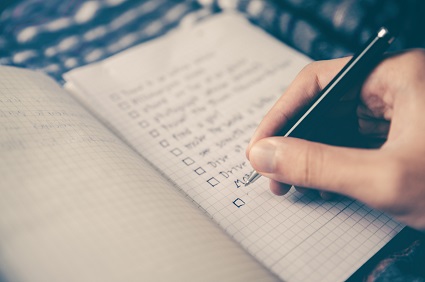Reading too many productivity blogs can be counter-productive
You read productivity blogs right? You must be a good productive citizen.
Every day you:
- Wake up at 5am
- Meditate for 20 minutes
- Make Bullet Proof coffee
- Take your vitamins
- Read for an hour
- Journal about your ‘grand vision’
- Write 3 things you’re grateful for
- Stretch for 20 minutes, on the porch, as naked as possible (get your vitamin D!)
- Write 10 new ideas
- Practice dual-n-back for 20 minutes
- Work on your ‘side-hustle’
- Go for a brisk walk
- Network with someone new at lunch, where you eat the salad you packed
- Inbox zero your email
- Read productivity blogs
- Lift weights or Interval train or yoga
- Listen an episode The Tim Ferris Show
- Drink one glass of red wine (but only one)
- Study your foreign language flash cards
- Check in with your accountability coach
- Update your Beeminders / Stikks
- Watch a lecture from that online ‘mastermind’ course you bought
- Turn off screens 2 hours before bed
- Take a bath and drink some calming tea
- Reflect on your day in your journal
- Brush your teeth and floss
- In bed at 9pm - your room is blacked out and temperature controlled so you fall asleep instantly
You have all of these productive habits, right?
You don’t?
How could you not!? Studies show that if you miss one of these you’ll be doomed to a life of mediocrity. Don’t you want to succeed?
You’d better get disciplined or you’ll be doomed to mediocrity.
=====
Maybe intellectually you know that this is probably too much stuff. You don’t actually have to do any of these to succeed.
But there’s still that fear, the fear that if you don’t do all these ‘hacks’ you’ll be left behind, doomed to penny pinch while your colleagues make it big.
Let’s talk about how to combat that fear.
Productivity Overwhelm
If you read enough ‘self-help’ or ‘productivity’ blogs, it’s easy to get bogged down with things you ‘should be’ doing. And if you really want these tasks to make an impact you’d better do them everyday, and turn them into habits.
It’s easy to read blogs. Every article you read turns into another ‘actionable takeaway’ that you add to your list. But it’s hard to actually implement new habits. So you end up with a list of tasks so long it doesn’t even fit on your laptop screen. You feel like you ‘should’ be doing all of these, but there’s a lot of things to do, and you’re busy, and now you’ve been putting off all of them for weeks. Your ’to-do’ list becomes your ‘should-do’ list.

ugh.
One day, you read a motivational quote and get so motivated that you finished every single one of your tasks. Hooray! You’re pumped! The motivation keeps you going for the next day, or even two.
But after a few days the motivational thoughts wear off. You get sick or an emergency comes up or you have an off day. Your ‘should do’ list is piling up, and that dread is coming back. The list becomes daunting, overwhelming, paralyzing. You’re back in the Productivity Overwhelm trap.

Save me from my to-do list Mr. Corgi!
Tools for dealing with productivity overwhelm
How do we fight back against productivity overwhelm? With some shifts in our approach.
Say No by default
The easiest way to avoid having an overwhelming ‘should-do’ list is to say no by default.
When you read an article, and find an interesting action item, don’t do it. If the new action is really compelling, put it in a ‘maybe / someday’ list. A few weeks or months down the road, you’ll look at your ‘maybe / someday’ list and realize most of the tasks aren’t useful. If a new action compels you week after week, then you can think about adding it in.
Say no to adding tasks to your day.
Read fewer productivity blogs
Saying no includes saying no to “productivity porn”. Reading short articles about productivity feels good. You don’t have to work very hard to read ‘Improve Your Productivity With These 8 Unbelievable Hacks!’, even though you think you’re being useful.
If you’re putting off real work to read articles, there’s something wrong. If you’re reading about hacks for 1-2% improvements (‘Speed up your mouse cursor!’) but failing to hit the fundamentals[1], you’re wasting your time.
I’m not saying read zero productivity articles, there’s a lot of great information out there [2]. Just make sure you aren’t spending more time reading about productivity than actually being productive.
Beware of the ‘Any Benefit Mindset’
Watch out for the ‘Any Benefit Mindset’. These techniques and hacks and tools all end up on our todo list because we think we’ll get something out of them. But just because something has a benefit, doesn’t mean it’s worth doing.
Any Benefit Mindset: [Thinking that] you’re justified in using a…tool if you can identify any possible benefit to its use, or anything you might possibly miss out on if you don’t use it.
Don’t do something just because it might have a benefit. Only take on actions when the benefits are obviously positive, or the downside of not doing it is obviously detrimental.
Just because a blogger claimed standing on one foot while singing a song backwards every morning “Improved my output by 10x!!!” doesn’t mean you have to do it too.
Remember, there is always a cost to performing a task, no matter how small. Make sure the benefit is worth the effort.
Add One thing at a time
When you do add new daily habits, make it one at a time. Even if you feel like you’ve got the extra bandwidth to handle more today, remember that you may not have that bandwidth tomorrow. Keep it simple, one thing at a time.
More on ‘working in serial’ here.
Chunking
Ask a runner what their daily exercise routine is like. You’ll get a response like, “Oh I just run for 3 to 5 miles, then stretch.”
Ask someone who hates running how they’d go for a jog. “Well, first I have to change into running clothes, then I have to put on running shoes, then I have to figure out how far I should run, then I have to figure out a path to run around my neighborhood, then I have to run and convince myself not to stop, then…, then…., then…”
Why is the process for the runner so much simpler? The runner has ‘chunked’ the whole process into one straight-forward task.
You do the same thing all the time. When you brush your teeth or make toast or buy something from the store you’re chunking dozens of actions into one simple task.
Here’s a few ways to ‘chunk’ productivity tasks:
- Have a morning routine
- Use a pre-formatted journal
- Use an existing habit to trigger a new one (‘brush teeth’ becomes ‘brush teeth and floss’)
Remember: You don’t need to fill your day with ‘productive’ tasks to live a full life
“we need randomness, mess, adventures, uncertainty, self-discovery, near-traumatic episodes, all those things that make life worth living, compared to the structured, fake, and ineffective life of an empty-suit CEO with a preset schedule and an alarm clock.”
Nassim Taleb - Antifragile
What did I miss?
Do you struggle with productivity overwhelm? How do you cope with it? Are there any strategies you have that I didn’t mention?
Let me know on Twitter @uberstuber or email james@jamesstuber.com
Want to level up your productivity without overwhelm?
We built an interactive coach, available 24⁄7 to give you a feasible next step to improve your productivity skills.
Get the Digital Productivity Coach
Fundamentals you must establish before looking for small wins:
- Sleep 8 hours a night
- Eat real foods 90% of the time or more
- Turn off phone and computer notifications for everything
Productivity blogs with high signal-to-noise ratio:
Further Reading